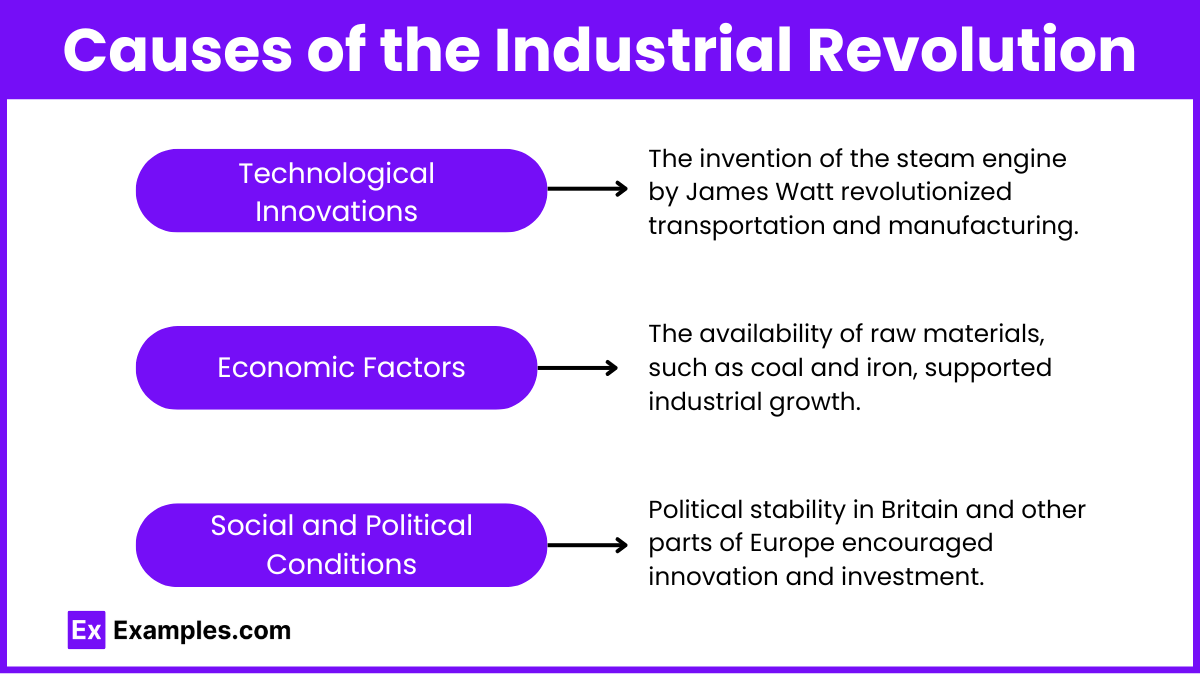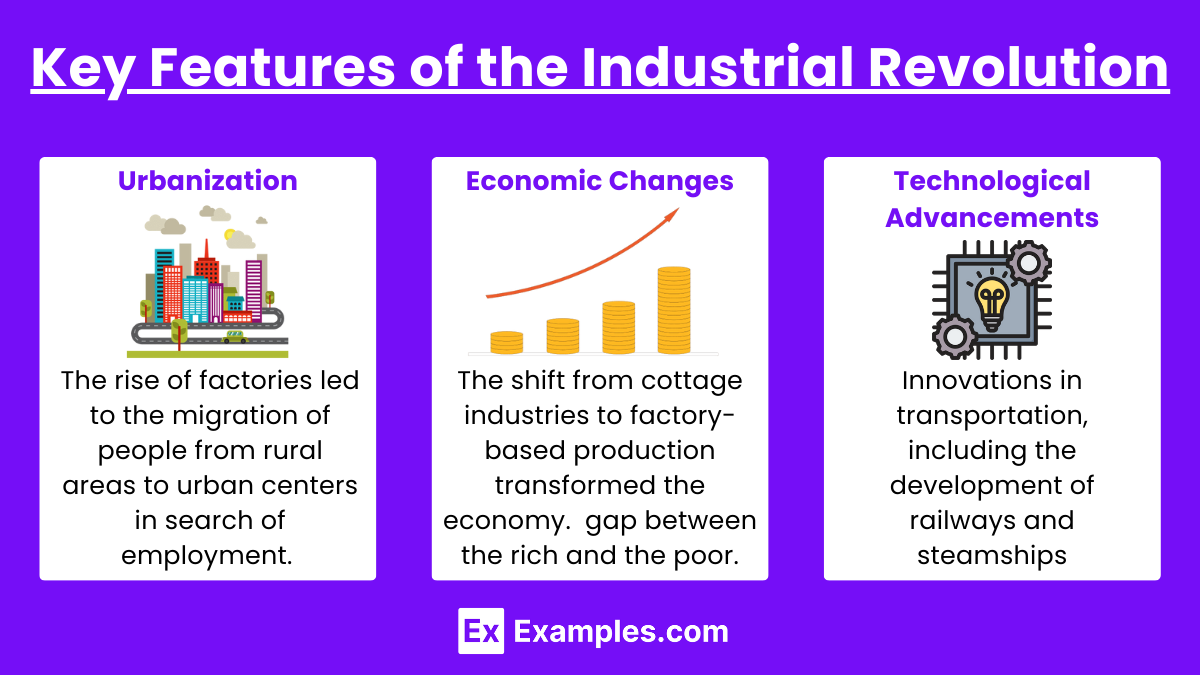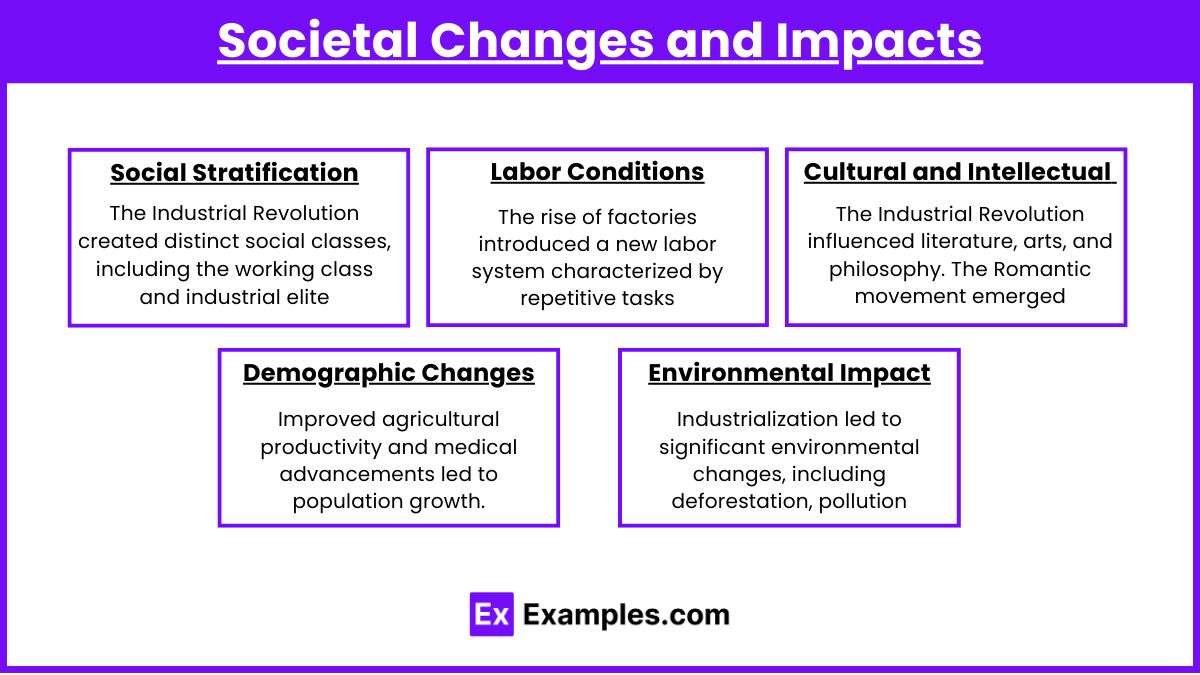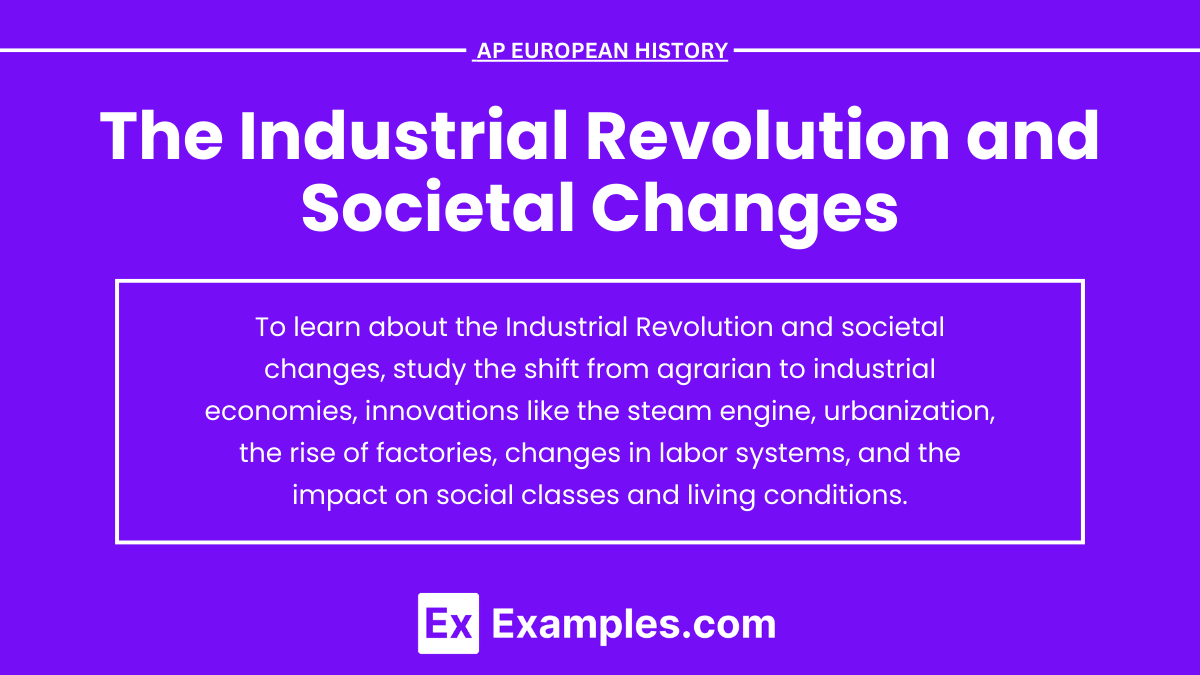The Industrial Revolution, beginning in late 18th-century Britain, was a pivotal era of technological innovation and economic transformation. It marked the shift from agrarian societies to industrialized urban centers, fundamentally altering production processes and societal structures. This period saw the rise of factories, the growth of cities, and significant changes in labor and class dynamics. The resulting social changes, including urbanization, shifts in family roles, and the emergence of new social classes, had profound and lasting impacts on European and global history.
Learning Objectives
By studying "The Industrial Revolution and Societal Changes" for the AP European History exam, you should understand the causes and technological innovations driving industrialization, analyze the economic and social impacts on different classes, and evaluate the consequences of urbanization and labor changes. You should also explore the cultural and intellectual responses, including Romanticism, socialism, and liberal reforms. This knowledge will help you contextualize the broader effects of the Industrial Revolution on European history and its lasting influence on modern society.
Causes of the Industrial Revolution

Technological Innovations:
The invention of the steam engine by James Watt revolutionized transportation and manufacturing.
The development of machinery, such as the spinning jenny and power loom, improved textile production.
Economic Factors:
Capital accumulation from overseas trade and colonial exploitation provided the necessary funds for investment in new technologies and industries.
The availability of raw materials, such as coal and iron, supported industrial growth.
Social and Political Conditions:
Political stability in Britain and other parts of Europe encouraged innovation and investment.
The rise of a capitalist economy and the decline of feudalism fostered a conducive environment for industrial growth.
Key Features of the Industrial Revolution

Urbanization:
The rise of factories led to the migration of people from rural areas to urban centers in search of employment. This rapid urbanization resulted in the growth of cities such as Manchester and Birmingham.
Economic Changes:
The shift from cottage industries to factory-based production transformed the economy. This transition led to the creation of a working-class population dependent on wage labor.
The rise of industrial capitalism saw the emergence of wealthy industrialists and a widening economic gap between the rich and the poor.
Technological Advancements:
Innovations in transportation, including the development of railways and steamships, facilitated faster movement of goods and people.
Advancements in iron and steel production, such as the Bessemer process, contributed to the expansion of industries.
Societal Changes and Impacts

Social Stratification:
The Industrial Revolution created distinct social classes, including the working class, middle class, and industrial elite. The working class faced harsh working conditions, long hours, and low wages.
The middle class, comprising entrepreneurs, professionals, and managers, benefited from the economic opportunities created by industrialization.
Labor Conditions:
The rise of factories introduced a new labor system characterized by repetitive tasks, long working hours, and unsafe conditions. Child labor and exploitation were prevalent.
These conditions led to the formation of labor unions and the eventual push for labor reforms, including laws regulating working hours and conditions.
Cultural and Intellectual Changes:
The Industrial Revolution influenced literature, arts, and philosophy. The Romantic movement emerged as a reaction against the perceived dehumanization of industrial society, emphasizing emotion and nature.
The period also saw the rise of new ideologies, such as socialism and Marxism, which critiqued the inequalities produced by industrial capitalism.
Demographic Changes:
Improved agricultural productivity and medical advancements led to population growth. However, urban areas often suffered from overcrowding, poor sanitation, and health issues.
Environmental Impact:
Industrialization led to significant environmental changes, including deforestation, pollution, and the depletion of natural resources. The smoke and waste from factories polluted air and water, affecting public health.
The Industrial Revolution's Global Impact
Global Trade and Imperialism:
The demand for raw materials and markets for manufactured goods drove European powers to expand their colonial empires. This imperialism had long-lasting effects on the colonized regions, shaping global trade patterns and cultural exchanges.
Spread of Industrialization:
The technological innovations and industrial techniques developed in Europe spread to other parts of the world, leading to global industrialization. This spread had varied impacts on different regions, often leading to economic and social upheaval.
The Industrial Revolution was a transformative period that reshaped European society and the world at large. Its legacy includes significant technological advancements, economic changes, and societal transformations. Understanding these developments is crucial for analyzing the broader trends in European history and their global implications.
Examples of The Industrial Revolution and Societal Changes
Urbanization : The Industrial Revolution led to a massive migration of people from rural areas to cities. This urbanization occurred as factories and industrial centers provided more job opportunities, leading to the growth of cities like Manchester and Birmingham in the UK.
Changes in Labor : The introduction of machinery and factories transformed traditional labor practices. Artisans and craftsmen were replaced by factory workers, and the concept of wage labor became more widespread. This shift led to the development of a working class and changes in labor conditions, including long working hours and the rise of child labor.
Technological Innovations : Significant technological advancements, such as the steam engine, spinning jenny, and power loom, revolutionized production processes. These innovations increased efficiency and productivity, paving the way for mass production and the growth of industries such as textiles and manufacturing.
Socioeconomic Stratification : The Industrial Revolution created a distinct divide between the wealthy industrialists and the working class. The emergence of a new bourgeoisie, or middle class, comprised of business owners and professionals, contrasted sharply with the often poor working conditions experienced by factory laborers.
Changes in Lifestyle and Culture : The Industrial Revolution brought about significant changes in lifestyle and culture. With the rise of factories and urban living, traditional family structures and community ties were altered. New social norms and cultural practices emerged, influenced by the rapid pace of technological and economic changes. This period also saw the rise of consumer culture, with increased availability and diversity of goods.
Practice Test Questions on The Industrial Revolution and Societal Changes
Question 1: Which of the following was a significant change brought about by the Industrial Revolution?
A) Increased reliance on agriculture
B) Decreased urbanization
C) Growth of factory-based production
D) Decline in technological advancements
Answer: C) Growth of factory-based production
Explanation: The Industrial Revolution marked a major shift from agrarian economies to industrial ones. One of the most significant changes was the growth of factory-based production. This period saw the rise of factories that used machinery for mass production, leading to increased efficiency and the development of new industries. This transformation was in stark contrast to the earlier reliance on agriculture and small-scale artisanal production.
Question 2: What was one of the main societal impacts of the Industrial Revolution in urban areas?
A) Decline in population due to poor living conditions
B) Increased opportunities for rural employment
C) Rapid urbanization and population growth
D) Reduction in social class disparities
Answer: C) Rapid urbanization and population growth
Explanation: The Industrial Revolution led to rapid urbanization as people moved from rural areas to cities in search of employment in factories. This migration caused significant population growth in urban areas, often leading to overcrowded living conditions and the development of new social dynamics. The shift also resulted in various social challenges, such as inadequate housing, poor sanitation, and increased poverty, highlighting the need for reforms.
Question 3: How did the Industrial Revolution influence the labor market?
A) Decrease in child labor due to stricter regulations
B) Increase in skilled artisan employment
C) Rise in unskilled labor demand and harsh working conditions
D) Decrease in women's participation in the workforce
Answer: C) Rise in unskilled labor demand and harsh working conditions
Explanation: The Industrial Revolution brought about significant changes in the labor market. There was a high demand for unskilled labor, as factory jobs often required minimal training and could be filled by a wide range of people, including women and children. This demand led to the proliferation of harsh working conditions, including long hours, low wages, and unsafe environments. The exploitation of workers, particularly children, became a critical issue, eventually leading to labor reforms and the establishment of labor rights.


